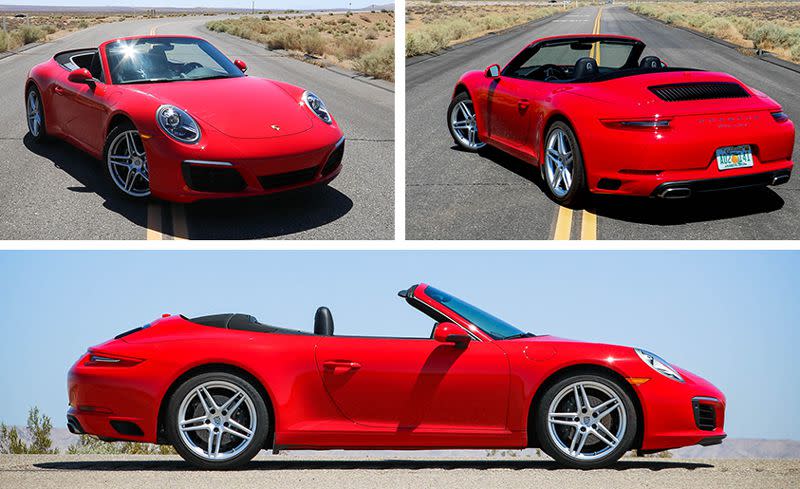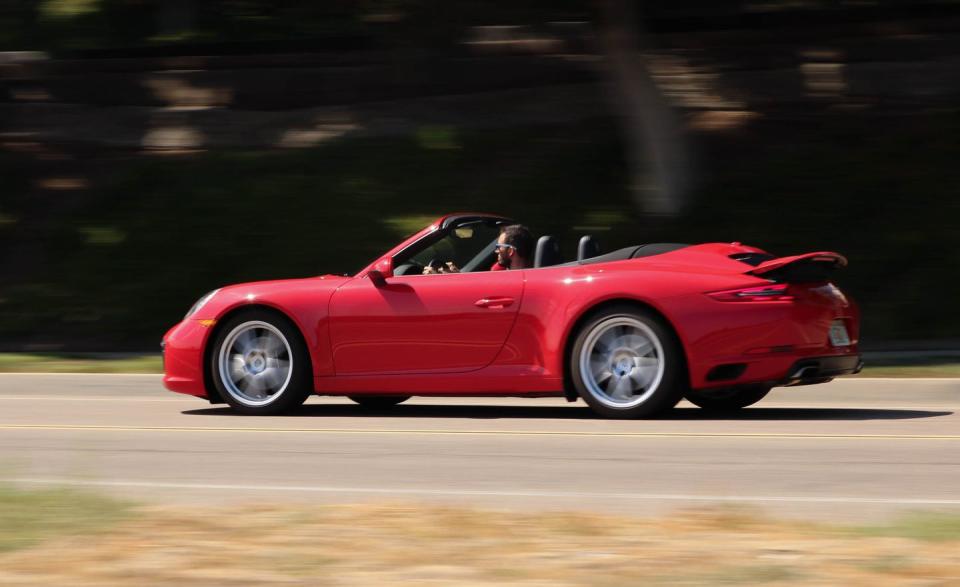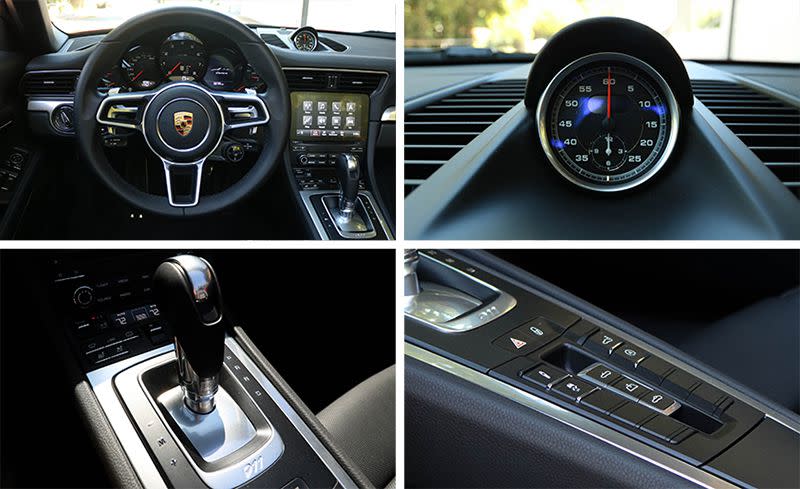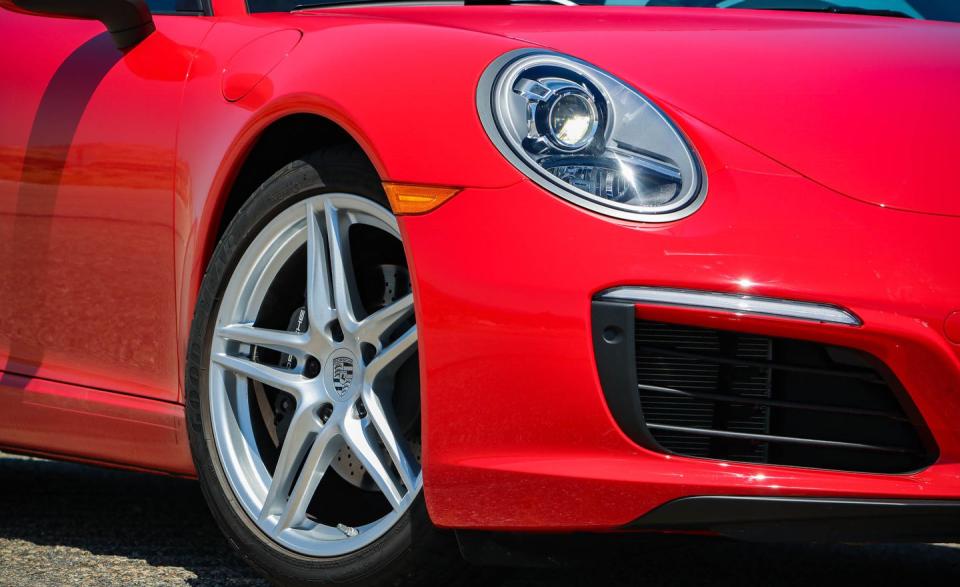2018 Porsche 911 Carrera Cabriolet PDK Automatic
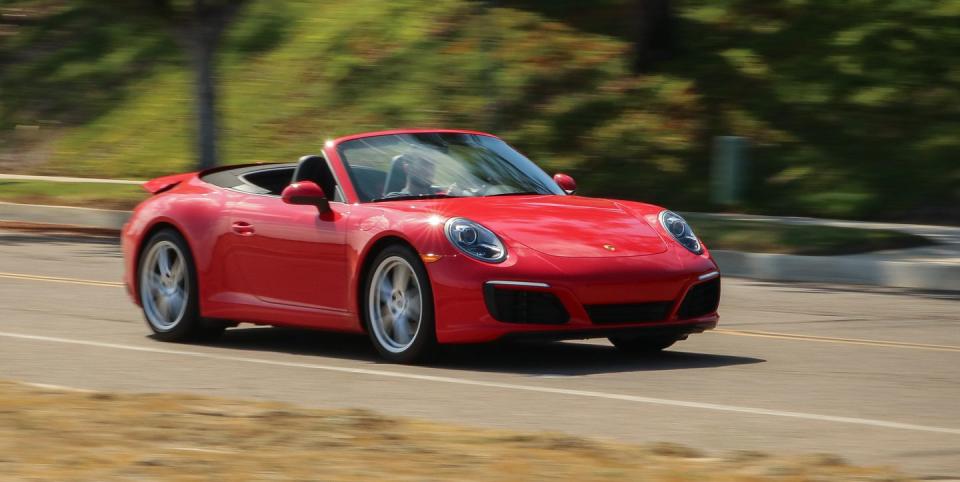
This is going to be a kick-ass used car. It’s the plainest, most ordinary, least powerful, least expensive new Porsche 911 in cabriolet form, with narrow hips and an automatic transmission. It’s the 911 that rich guys buy their mistresses, rich women buy for their tennis-pro boy toys, and the one to get if you’re only leasing. It’s a Carrera, but there’s no 4, no S, no GTS and no T. Like all new 911s-save for the GT3 models-it’s a turbo but this one is not a Turbo. It is the 370-hp 911 you buy when you can barely afford a 911. Only the folding top separates it from the basest of 911s.
But it’s so good it makes any driver feel like the master of their domain.
For even deeper coverage of the 911, view our Buyer’s Guide in-depth review.
Fast, Stupid Fast, Insane Fast
Here’s the bottom line: zero to 60 mph in 3.5 seconds with the quarter-mile flying by in 11.9 at 117 mph. Except for a 3-mph difference in quarter-mile terminal velocity, this 3462-pound, rear-drive, automatic-transmission 911 cabriolet matches the performance achieved by its putatively more powerful sibling, the 3421-pound, all-wheel-drive, manual-transmission, 450-hp 911 Carrera 4 GTS coupe that C/D tested. In turn, those numbers are both 0.1 second quicker than the legendary Porsche 959 supercar achieved in 1987. That’s right, at this point the least powerful new 911 cabriolet with an automatic is, by virtually all performance measures, a 959.
This 911 pulled a full 1.00 g on the skidpad, too. While wearing 19-inch wheels shod in Goodyear Eagle F1 Asymmetric 2 rubber, sized 245/40ZR-19 up front and 295/35ZR-19 at the rear rear. Those are the standard tires, the ones that have an actual sidewall.
With a base price of $104,450 and an as-tested price of $115,950, this 911 seems nearly, almost, not quite cheap. Cut out frivolities such as $540 worth of red seatbelts, the $2330 14-way power sport seats, and a lane-change-assist system that goes for $850, and it’s easy to knock the total chit down to just over $110,000. After all, if you can’t change your own damned lanes, why are you getting a new 911?
Only two options on this car matter. And they matter a lot.
Miracle Grow
At the heart of this 911 Carrera-but filling the tail-is a 370-hp twin-turbocharged 3.0-liter flat-six that produces a deep well of 331 lb-ft of torque from just 1700 rpm up to 5000 rpm. (And the output barely droops down running to the 7400-rpm redline.) It has the same displacement as the six in the 420-hp Carrera S, but the not-an-S model runs smaller turbos that produce 13.1 psi of boost, while the S’s big blowers heave in atmosphere at the rate of 16.0 psi.
Compared with Porsche’s previous not-marketed-as-a-Turbo 911 engines (1964 to 2016), both today’s standard and S engines pull like locomotives from low revs. It may give up 50 horses to the S, but this lower-key six feels spectacularly muscular. And it’s utterly forgiving, too; brain-fart and let the engine lug and it offers instant torque to save the driver’s dignity. Maybe an expert like Jochen Rindt could detect some turbo lag, but he’s been dead for almost 50 years and was therefore unavailable for comment.
An indication of the engine’s lag is comparing a rolling start acceleration from five to 60 mph to the zero-to-60-mph time. The 911 cab’s delta is 0.9 second, not the best and certainly not the worst, although in top gear it slams from 50 to 70 mph in only 2.8 seconds.
But as glorious as the engine is, it’s the PDK dual-clutch automatic transmission that gets the most out of it. This seven-speed gearbox may actually be inhabited by Rindt’s ghost. Lashed to a dual-mass flywheel, the computer can shift better than all but the most deeply spiritual of 911 whisperers. And it’s more consistent than any human. The brilliance of the algorithms embedded in the PDK makes that 3.5-second zero-to-60-mph performance possible. Well, that and the launch-control program that comes as part of the Sport Chrono package. With launch control engaged the car is so good at acceleration it feels as if it won’t stop until it reaches escape velocity and breaks free of the earth’s gravity.
The two indispensable options for max performance on the 911 Carrera, then, are the PDK at $3210 and the Sport Chrono package at $2610. Get those and skip all the other upgrades and the 911 Carrera cabriolet is $110,270. Determined to stay under six figures? Start with a lighter-weight coupe at a base price of $92,150, and the total is $97,970.
Stop At 19
Former Car and Driver editor-in-chief Csaba Csere recently purchased a new 911 Carrera coupe as he slaloms through his semi-retirement as a C/D contributor in Colorado. And he chose to stick with the 19-inch wheels like those on this test car. “This car is my daily driver, and I wanted to minimize this noise, ride harshness, and have a little more sidewall for pothole resistance,” he explains. “So far, I haven't had any pothole damage and the ride is superb-firm and well controlled with minimal harshness.” That was C/D’s experience with this cabriolet as well.
But while Csaba’s coupe wears Yokohama Advan Sport V105s, our test cabrio was on the aforementioned Goodyears. Both deliver instantaneous turn-in and astonishing grip, but Csere reports that road noise in his coupe can become irritating on concrete surfaces. Tested in Southern California, the cabriolet’s Goodyears didn’t seem to produce the same roar. But, well, most of the time the top was down in the cab because, hey, it’s summer in Southern California. That in mind, tire noise may be worth considering when ordering a new 911.
Except for the conspicuous consumption they represent, larger diameter wheels are wasted on any 911 Carrera destined for street use. The 19s offer plenty of stick, ride better, and the additional sidewall rubber doesn’t just protect against ride harshness and potholes, but wheel-scraping on curbs, too. Get the 19s and sleep well knowing you’ve made the right choice.
Everything Good
The 911 Carrera sits at the very center of automotive enthusiasm, a dense well of gravity around which all other sports and GT cars orbit. This cabriolet may be the least among 911s in some ways, but it isn’t a compromise in any significant way. It’s ridiculously quick and works perfectly as a daily driver. Everything about it is terrific.
Still, it might be best to wait. New PDK-equipped 911 Carrera cabriolets are currently flooding the streets of Beverly Hills, Palm Beach, the Hamptons, and the better neighborhoods around the Chicago Loop. It’s the 911 Carrera least likely to be driven by people who are going to beat them up on racetracks or crash them into telephone poles while racing a Ferrari 488 along Sunset Boulevard. It’s the 911 most likely to be driven by people who don’t know how good it is.
So there will be a lot of them. And unlike the GT3s, upper-case Turbos, or Targas, they will be the least likely to be considered “collectible” or to show up on a lawn at a future Rennsport Reunion. They’re likely to take the greatest depreciation hit of all the 911s-and that will make them relative bargains as leases expire in two or three years. If you can bear to hold out that long.
You Might Also Like

 Yahoo Autos
Yahoo Autos 